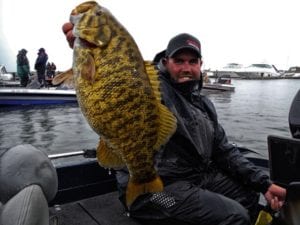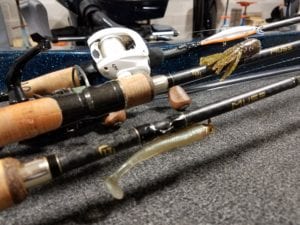Getting Big Bronzebacks in the Boat this Spring
Adam Rasmussen is a full time fishing guide, who lives in Stevens Point, WI and guides for all species of fish, but his true passion is heading northeast from his home and fishing the waters of Sturgeon Bay for BIG smallmouth!
Over the last two weeks, Adam and his tournament partners have weighed in over 105 lb’s of smallmouth (twenty fish), resulting in an average weight of 5.29 lb’s per fish, quite an astonishing statistic.
Despite there being smallmouth on beds, Adam prefers to target pre spawn smallmouth this time of year as these bass will weigh more than bedded smallies, they’ll receive less pressure during an event and they won’t get burned out as quick by other anglers fishing for them.
Adam will begin his search for pre spawn smallmouth near spawning bays or flats that will warm sooner than other areas of the lake, for Sturgeon Bay this is the southern bays, such as Riley’s, Sand and Little Sturgeon. “These bays will warm first, so our goal is to position our self between the spawning flat and the deep water, this way we can intercept the waves of smallmouth as they begin to pull up,” stated Adam.
The water temperatures in these areas can be five to eight degrees warmer than other areas of the lake, which also translates into the smallmouth being more active and eager to eat.
It is no secret that smallmouth like transition areas and Adam keeps it simple when looking for key pre spawn smallmouth areas. He will identify the shallow flats (2’ to 6’) that the smallmouth will spawn on and then find the depressions (4’ to 8’) or tight break lines that funnel those bass into the spawning flats. “The key thing to identify is that transitions from rock to sand, smallmouth love it and if you can find some big boulders, those will hold more heat,” said Adam. “The heat those big boulders hold is important when those overnight lows dip down.”
When it is calm and the sun is out, Adam can visually search out these areas, but if the wind is blowing or the depressions are in that ten foot or plus range, Adam will rely on his Humminbird electronics to side image areas to locate key boulders. This year LakeMaster’s Great Lakes mapping chip is exceptional at providing anglers with the data needed to identify these areas with ease. “It is amazing to see where my waypoints from ten years ago are set up on the LakeMaster map now, they are spot on to the key areas I had located,” chuckled Adam.
Being that many productive smallmouth waters are affected by the wind, putting waypoints on the key structure and transition areas is extremely important, as you can still fish these areas then, even if the water becomes muddy or the wind is blowing hard.
Following this game plan is how Adam won the Sturgeon Bay Bass Tournament (May 12 -13) with ten bass for 57.5 lb’s and took third in the annual Sturgeon Bay Open (May 20-21) again with ten smallmouth for 48.25 lb’s.
Once Adam has located the areas with big pre spawn smallmouth, he has a three prong attack to catch those fish.
Jerkbait: Rapala Shadow Rap (shallow) in natural colors, fished very aggressively
Tube: Crooked Creek or Northland Tackle Impulse Tube fished on a 1/8 to 3/8 oz jighead. The weight is dependent on the wind and depth of water being fished
Swimbait: The new Storm 360GT (3 ½”, 1/8 oz) can be fished slow in 2’ to 5’ feet of water and unique head design has a slow fall
Not only are anglers competing in the tournament, but as Adam commented, it becomes a casting contest during the day. “Making LONG casts is crucial as smallmouth get very aware of things this time of year and if it is calm, the longer cast you can make, the more successful you will be,” stated Adam.
Some common mistakes Adam see’s anglers making this time of year when fishing for pre spawn smallmouth include, fishing too fast and too far off the bottom. This time of year, the smallmouth are feeding on crawfish and goby’s, so they are feeding near the bottom and with the cooler water temperatures a big six pound smallmouth isn’t going to move very far to eat.
“My biggest piece of advice is to keep your bait in the strike zone for as long as you can,” state Adam. “Keep it low and slow is my moto!”
For more information on Adam’s guide service, you can visit his website, http://www.rasmussenoutdoors.com/ or his Facebook page, RasmussenOutdoors.



















